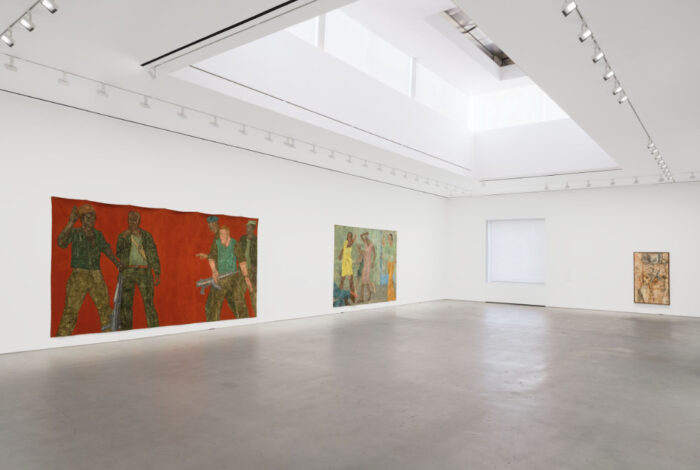
Et In Arcadia Ego
Leon Golub with Philip Guston, David Hammons, Rashid Johnson, Wifredo Lam, Sharon Lockhart, Robert Longo, Teresa Margolles, Tiona Nekkia McClodden, and Taryn Simon
Conceived by Rashid Johnson
5 September – 19 October 2024 Hauser & Wirth New York, 22nd Street
Rashid Johnson’s curatorial vision in “Et In Arcadia Ego” creates a vivid dialogue between Leon Golub’s forceful, politically charged paintings and the work of various artists who echo or expand on his concerns. The exhibition, anchored by Golub’s sprawling career from the 1950s to the 1990s, is a study in power, vulnerability, and the often brutal realities of conflict. Through Golub’s potent imagery, viewers are thrust into a tense examination of humanity’s darker impulses, while the group exhibition on the second floor broadens the conversation to include contemporary reflections on these enduring themes.

The second-floor display acts as a crucible of shared exploration, where artists such as Philip Guston, David Hammons, and Tiona Nekkia McClodden add layers to the psychic and sociopolitical dimensions of Golub’s work. The selection illustrates not just how Golub depicted the abuses of power, but how others have carried the mantle forward, interrogating violence, control, and personal agency. It’s a thoughtful juxtaposition of mediums and epochs, heightened by text from Amiri Baraka and Samuel Beckett, whose prose punctuates the visual cacophony with meditations on the human condition.

Johnson’s decision to title the show after Golub’s painting Time’s Up invites viewers into an intellectual lineage that stretches from Baroque classicism to postmodern existentialism. Golub’s appropriation of the phrase “Et In Arcadia Ego”—traditionally a reminder of death in paradise—becomes a multifaceted symbol in his work, emblematic of mortality, state violence, and the artist’s deep engagement with historical trauma. This exhibition cleverly traces Golub’s intellectual roots, from his studies in art history to his firsthand experiences of war, infusing his works with a timeless urgency that reverberates in today’s global landscape.
As Johnson reframes Golub’s legacy through what he terms a “kaleidoscopic unpacking,” the exhibition succeeds in demonstrating Golub’s sustained relevance. Through Golub’s direct, sometimes confrontational imagery, Johnson invites viewers into a broader, cross-generational conversation about the persistence of power, suffering, and the artist’s role as witness. The inclusion of new works by Tiona Nekkia McClodden and Robert Longo reinforces this idea, positioning the exhibition not merely as a retrospective of Golub’s career but as an ongoing, evolving discourse on how art can confront, resist, and reflect the complexities of the human experience.


